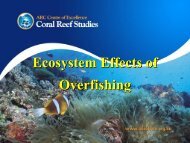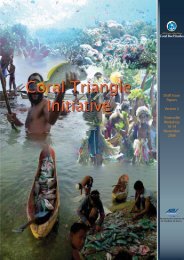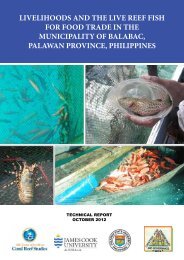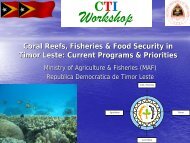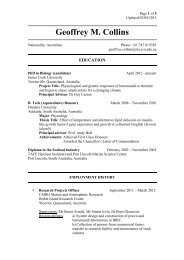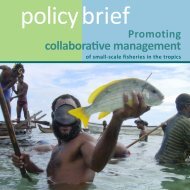Roger Beeden â GBRMPA
Roger Beeden â GBRMPA
Roger Beeden â GBRMPA
Create successful ePaper yourself
Turn your PDF publications into a flip-book with our unique Google optimized e-Paper software.
Coral Triangle Initiative:<br />
Coral Reefs, Fisheries and<br />
Food Security<br />
Climate Change Adaptation<br />
and Tropical Reefs<br />
Dr. Janice Lough – AIMS<br />
Prof. Ove Hoegh-Guldberg – UQ<br />
<strong>Roger</strong> <strong>Beeden</strong> – <strong>GBRMPA</strong><br />
Cameron Darragh - DCC
Climate Change Adaptation and<br />
Tropical Reefs<br />
Presentation Overview<br />
Dr Janice Lough - AIMS<br />
• A changing climate for the Coral<br />
Triangle .<br />
Prof. Ove Hoegh-Guldberg<br />
- UQ<br />
• Climate change impacts on coral<br />
reefs – Critical thresholds .<br />
<strong>Roger</strong> <strong>Beeden</strong> – <strong>GBRMPA</strong><br />
• GBRMP case study - Climate<br />
change management challenges,<br />
needs and approaches.<br />
Cameron Darragh – DCC<br />
• The Australian governments focus<br />
on adaptation .
Climate Change –<br />
Management Challenges,<br />
Needs and Approaches<br />
Great Barrier Reef Marine<br />
Park Case Study<br />
<strong>Roger</strong> <strong>Beeden</strong><br />
Manager - Climate Change Group<br />
Great Barrier Reef Marine Park Authority
The Great Barrier Reef and the<br />
Coral Triangle – Areas of<br />
International Importance<br />
The Great Barrier Reef Marine Park<br />
• World’s largest coral reef system<br />
• 2,900 coral reefs, 350,000 sq kms<br />
• 836,000 people<br />
Like the CT the GBR includes highly diverse<br />
habitats and biological communities
Climate change challenges for<br />
the Great Barrier Reef<br />
Challenges<br />
Storm frequency & intensity<br />
Precipitation, drought & runoff<br />
Changing circulation<br />
Sea level rise<br />
Sea temperature<br />
Ocean chemistry
Healthy reef<br />
Climate Change Impacts on<br />
the GBR the story so far…..
Bleached reef<br />
5% damaged<br />
Climate Change Impacts on<br />
the GBR the story so far…..<br />
1998<br />
45%<br />
Unaffected<br />
50%<br />
Bleached<br />
2002<br />
5% damaged<br />
35%<br />
Unaffected<br />
60%<br />
Bleached
Damaged reef<br />
Climate Change Impacts on<br />
the GBR the story so far…..<br />
Keppel Islands 2006<br />
40% corals killed
Management Needs:<br />
Knowledge of Vulnerability<br />
Exposure Sensitivity<br />
(86 experts; 24 Chapters)<br />
Potential<br />
impact<br />
Adaptive<br />
capacity<br />
Vulnerability<br />
How do we manage with imperfect<br />
knowledge?<br />
• Climate scenarios = uncertainty<br />
• Vulnerability assessment = Expert<br />
judgement as a mechanism for<br />
dealing with uncertainty<br />
Cost<br />
Values<br />
Management Priority<br />
<strong>GBRMPA</strong> Climate Change Action Plan
Management Needs:<br />
Priority Actions<br />
Humans<br />
Almost all Great Barrier Reef species and habitats will be affected by<br />
climate change, some seriously.
Management Needs – Flexible<br />
Response Plans<br />
Coral Bleaching Response Plan<br />
Early warning system<br />
Forecast Nowcast Assessment & Monitoring
Recovery can take decades…<br />
…resilience is crucial<br />
Resilience is the ability of a system to absorb shocks, resist<br />
phase shifts and regenerate & reorganise… so as to maintain key<br />
functions and processes. The Resilience Alliance
Strategic Approach:<br />
Maximise resilience to avoid<br />
worst-case scenario<br />
• Reduce Global Greenhouse Gas Emissions……<br />
Reef condition<br />
temperature<br />
Pre-climate change<br />
Best-case scenario<br />
Worst-case scenario<br />
RESILIENCE<br />
1950 2000 2050<br />
2100<br />
• Protect Biodiversity – Representative Areas Program<br />
• Improve Water Quality - Reef Rescue Plan
Management approach –<br />
Minimise “chronic stressors”<br />
Biodiversity Protection<br />
‘Green’ zones protect examples of all habitat types<br />
‘Pink’ Zones = examples of key habitats as undisturbed<br />
reference areas<br />
All zones, other than ‘light blue’ zones, protect benthic<br />
habitat<br />
Other management measures<br />
• Dugong Protection Areas<br />
• Threatened Species Recovery Plans<br />
• Mandatory use of Turtle Excluder Devices<br />
• Bycatch Reduction Devices<br />
In 2004, the Reef was rezoned, increasing<br />
Green (no take) Zones from 4.5% to 33.3%
Management approach –<br />
Minimise “chronic stressors”<br />
Water quality issues<br />
Key management measures<br />
• Reef Water Quality Protection Plan/Reef<br />
Rescue<br />
• Regional Natural Resource Management<br />
Plans<br />
• Water Quality Improvement Plans<br />
(WQIPs)<br />
• Coastal and Local Government Plans<br />
• Wastewater and sewage guidelines,<br />
policies, legislation and regulations<br />
• Water Quality Guidelines
Management actions do work<br />
Coral trout<br />
Average biomass (g) per site<br />
(1500m 2 ) +/- SE<br />
3000<br />
2500<br />
2000<br />
1500<br />
1000<br />
500<br />
0<br />
Whitsunday Islands<br />
Blue<br />
Green<br />
Palm Islands<br />
Since 2004 coral trout numbers have<br />
rebounded by 31-75 per cent on the<br />
majority of reefs<br />
Source: Graham et al 2007
Management actions do work<br />
Photos: Environmental Protection Agency<br />
The implementation of moorings<br />
and no anchoring areas has<br />
reduced the incidence of anchor<br />
damage to coral
A healthy Reef requires<br />
effective partnerships
Building Capacity & Partnership<br />
Coral Reef Managers Guide<br />
Includes guidance and case studies on:<br />
• Preparing bleaching response plans,<br />
• Assessing the impacts of bleaching,<br />
• Engaging with the public,<br />
• Managing activities that may impact reefs<br />
during bleaching events,<br />
• Identifying resilient reef areas,<br />
• Incorporating reef resilience into marine<br />
protected area design,<br />
• Contributions from 17 experts,<br />
• Reviews by 34 world-renowned specialists on<br />
coral reef management, the causes and<br />
consequences of bleaching, and marine policy<br />
issues.
Building Capacity & Partnerships<br />
Responding to Climate Change: A workshop<br />
for Coral Reef Managers<br />
Preparing for Bleaching<br />
Events<br />
Responding to climate<br />
change impacts<br />
Understanding climate<br />
change and risks to<br />
reefs<br />
Building<br />
Resilience<br />
to Climate<br />
Change
A Strategic Approach-<br />
The Climate Change Action<br />
Plan for the Great Barrier Reef<br />
SST o C<br />
29<br />
28<br />
27<br />
26<br />
25<br />
Observed and projected annual GBR sea surface temperatures (1871-2006)<br />
Climate change (last-first 30 years) = +0.4 o C<br />
a. Observed and projected annual GBR SSTs 1871-2006<br />
Climate change (last - first 30 years) = +0.4 o C<br />
Goal:<br />
Increase the chances of the<br />
GBR coping with climate<br />
change.<br />
How:<br />
•Targeted science<br />
•A resilient GBR ecosystem<br />
•Adaptation of industries and<br />
communities<br />
•Reduced climate footprints<br />
Courtesy Janice Lough, AIMS<br />
1870 1900 1930 1960 1990 2020 2050 2080<br />
Year<br />
Adaptation<br />
High emissions<br />
GBR Resilience<br />
Mitigation<br />
A2<br />
B1<br />
Low emissions
The Great Barrier Reef Marine<br />
Park - multiple use ‘values’








